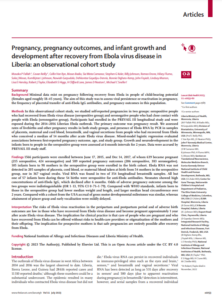
View Resource
Background
Minimal data exist on pregnancy following recovery from Ebola in people of child-bearing potential (females aged roughly 18–45 years). The aim of this study was to assess viral persistence or reactivation in pregnancy, the frequency of placental transfer of anti-Ebola IgG antibodies, and pregnancy outcomes in this population.
Methods
In this observational cohort study, we studied self-reported pregnancies in two groups: seropositive people who had recovered from Ebola virus disease (seropositive group) and seronegative people who had close contact with people with Ebola (seronegative group). Participants had enrolled in the PREVAIL III longitudinal study and were exposed during the 2014–2016 Liberian Ebola outbreak. The primary outcome was pregnancy result. We assessed rates of livebirths and other pregnancy results in both study groups, and presence of Ebola RNA by PCR in samples of placenta, maternal and cord blood, breastmilk, and vaginal secretions from people who had recovered from Ebola who conceived a median of 14 months after acute Ebola virus disease. Mixed-model logistic regression evaluated associations between first-reported pregnancy outcome, age, and study group. Growth and neurodevelopment in the infants born to people in the seropositive group were assessed at 6-month intervals for 2 years. Data were accrued by PREVAIL III study staff.
Findings
1566 participants were enrolled between June 17, 2015, and Dec 14, 2017, of whom 639 became pregnant (215 seropositive, 424 seronegative) and 589 reported pregnancy outcomes (206 seropositive, 383 seronegative). 105 infants born to 98 mothers in the seropositive group were enrolled in the birth cohort. Ebola RNA was not detected in 205 samples of placenta, cord blood, or maternal blood taken at birth from 54 mothers in the seropositive group, nor in 367 vaginal swabs. Viral RNA was found in two of 354 longitudinal breastmilk samples. All but one of 57 infants born during these 54 births were seropositive for anti-Ebola antibodies. Neonates showed high concentrations of anti-Ebola IgG, which declined after 6 months. Odds of adverse pregnancy outcome among the two groups were indistinguishable (OR 1·13, 95% CI 0·71–1·79). Compared with WHO standards, infants born to those in the seropositive group had lower median weight and length, and larger median head circumference over 2 years. Compared with a cohort from the USA accrual of gross motor developmental milestones was similar, whereas attainment of pincer grasp and early vocalisation were mildly delayed.
Interpretation
The risks of Ebola virus reactivation in the peripartum and postpartum period and of adverse birth outcomes are low in those who have recovered from Ebola virus disease and become pregnant approximately 1 year after acute Ebola virus disease. The implication for clinical practice is that care of people who are pregnant and who have recovered from Ebola can be offered without risks to health-care providers or stigmatisation of the mothers and their offspring. The implication for prospective mothers is that safe pregnancies are entirely possible after recovery from Ebola.